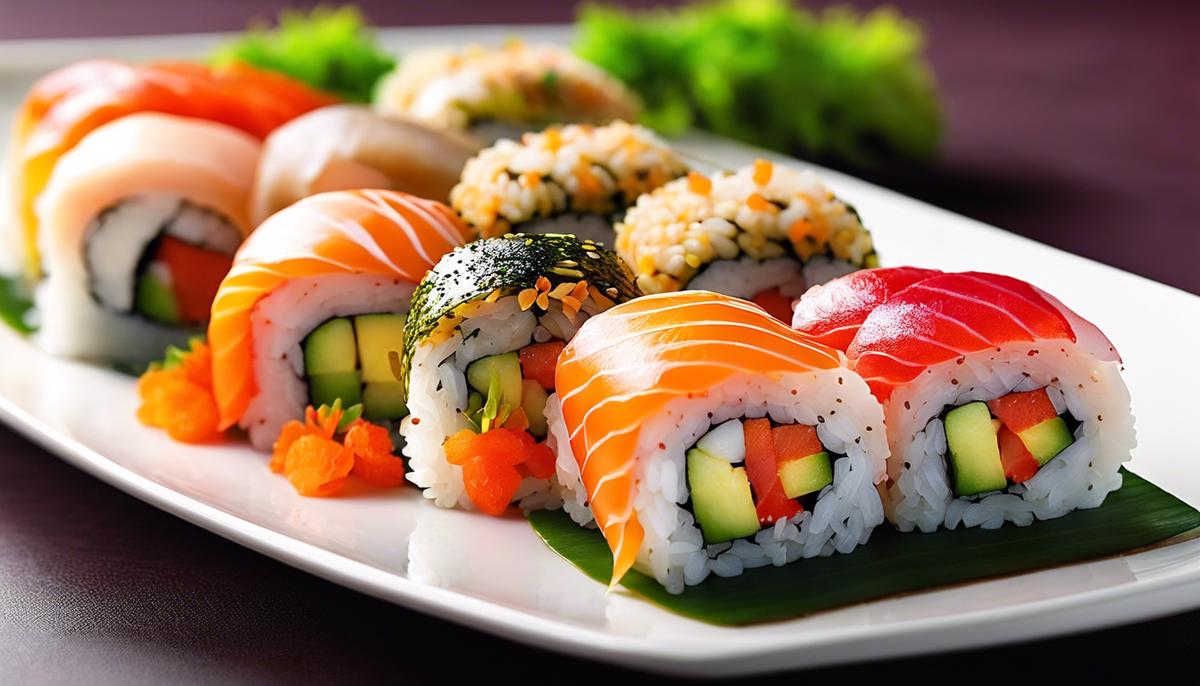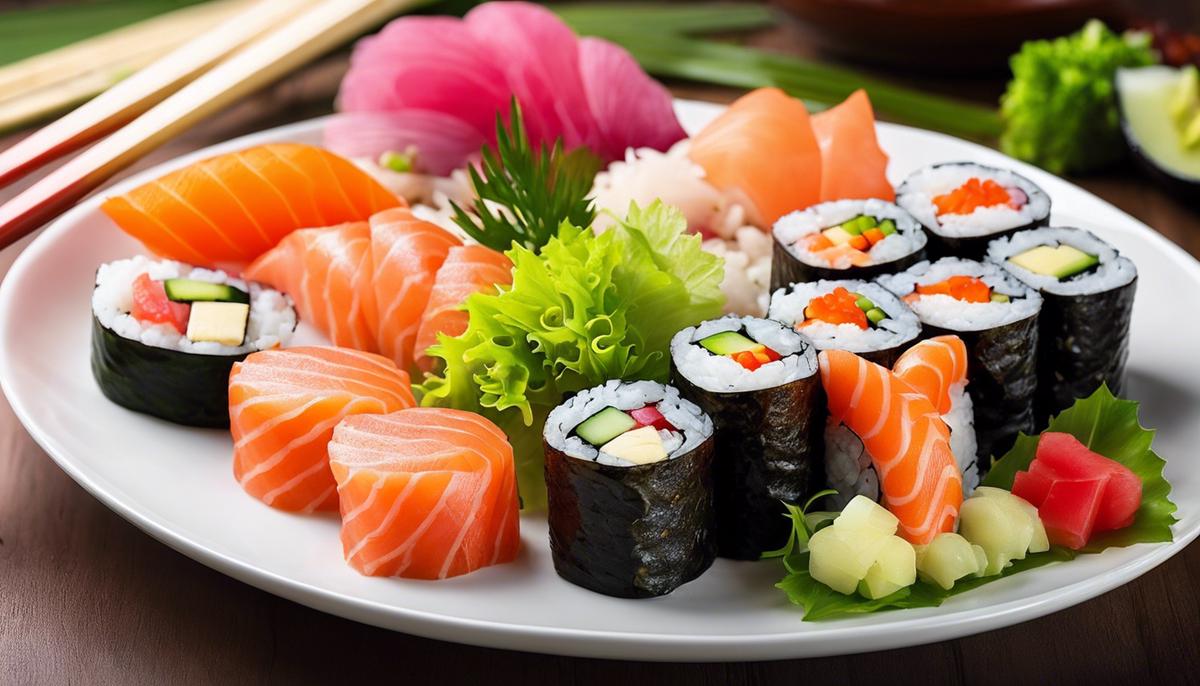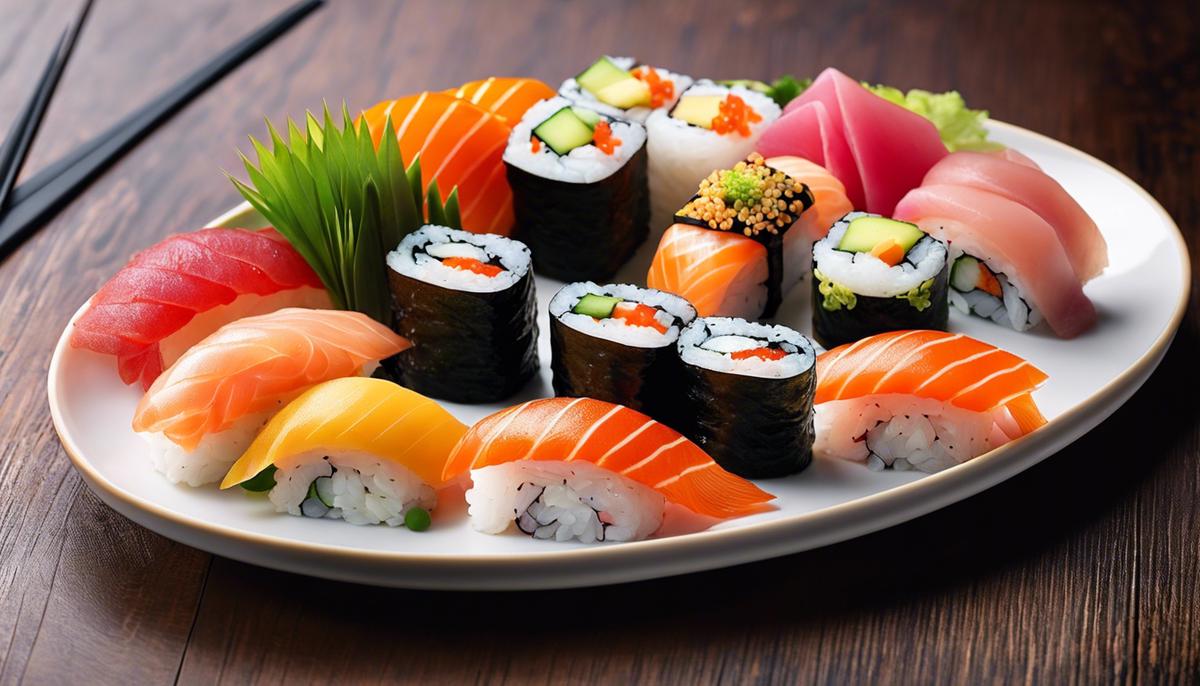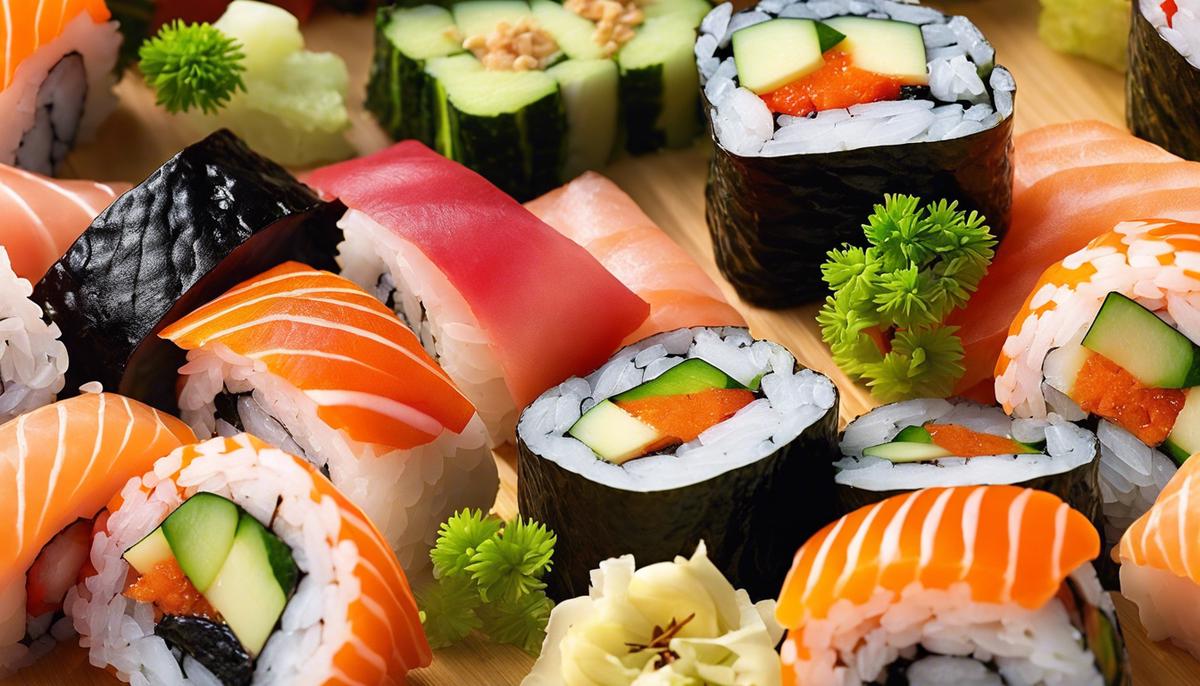The culinary phenomenon called sushi, which originated in the simple streets of Japan, has now become a global delicacy, served both on the street and on the finest porcelain. With its humble origins as a quick snack option for workers in the 19th century, sushi has come a long way. Today, it permeates modern cuisine around the world and has captured the palates of eaters of all ages and cultures.
The variety of sushi variations, ranging from traditional maki rolls to new, exciting fusion recipes, reflects the endless creativity and innovation of chefs from all walks of origin. The conscious and sustainable choice of ingredients in sushi makes it a healthy food that is becoming increasingly popular in today’s health-conscious society.
History of Sushi
Sushi. A word that captures the imagination of the global food community and embodies excellence and cultural enrichment. But what exactly is the origin of this enchanting delicacy and how has it influenced modern gastronomy?
Let’s start with the origins. Sushi has its origins in Su-se-ni, a Chinese method of preserving fish that originated around 400 BC. In the Middle Ages, sushi as we know it flourished in Japan. Around 1800, Tokyo street vendors served so-called “Edo-Mae sushi”, which is the origin of fast food that is popular all over the world.
Nowadays, sushi is much more than just a simple delicacy in the Western world. It is part of an extensive range of lifestyles. The “sushi trend” is more than just a single food; it is also a conception of aesthetics that permeates through the interplay of aromas, colors and textures.
This sushi culture is one of the biggest trendsetters in the kitchen of the 21st century. High-end restaurants and sidewalk cafes alike have recognized the potential of sushi and established it as part of their menu. Its popularity also extends to home-cooked cooking, with a plethora of online tutorials and courses that have taught cooking enthusiasts to master their own artful roles.
But there is the question: how has sushi influenced this gastronomic evolution? The answer lies in its simplicity and versatility. Sushi inspires chefs to experiment with minimalist approaches while still conjuring up stunning, flavorful creations. Technical finesse requires precision and patience, two essential qualities for a qualified chef.
Sushi has also made it possible to bring out regional ingredients in new settings. Many chefs have experimented and incorporated local seafood, meats, and vegetables into their roles.
In summary, from kabuki theater to fashion, Japan has taken a prominent role in the global art and lifestyle scene. However, one thing is certain, the influence of sushi on the world’s cuisine is undeniable. Every finely cut piece of tuna, every shiny ribbon noodle and every intricately shaped sushi roll tells the story of a culture that goes back centuries, impresses us and continues to be a source of inspiration.

Sushi and Health
At first glance, the health benefits of sushi seem obvious – it’s rich in high-quality proteins, vitamins, and minerals. But sushi offers much more than just these nutrients. First of all, it’s important to emphasize that sushi is a good source of omega-3 fatty acids, which are known to lower the risk of heart disease and protect the brain.
The main ingredients of sushi, such as fish and seafood, are an excellent source of iodine, which is necessary for healthy thyroid function. In addition, consuming sushi also helps to improve the balance of our intestinal flora. The fermented products found in many sushi dishes, such as pickled ginger or miso soup, are good probiotics that support the healthy bacteria in our digestive system.
It’s no secret that we live in a world where stress and hustle and bustle often take hold of us. That’s why it’s crucial to find ways to minimize these negative effects on our bodies. That’s where sushi comes in. The Zen-like practice of eating sushi – choosing each piece thoughtfully, chewing mindfully, and enjoying the different flavors – promotes a sense of calm and relaxation. It is a kind of meditative moment in the middle of our hectic everyday life.
However, the health aspects of sushi alone do not explain why it has become such an integral part of our lifestyle. Aesthetically pleasing, sophisticated, yet easy to make, sushi embodies many of the values valued in our modern society. The artistry and attention to detail that goes into every piece of sushi reflects our appreciation for craftsmanship and custom design.
So, on the whole, it can be said that sushi is an exquisite addition to our diet that nourishes both our body and our mind. It makes us be more mindful and appreciative while making us enjoy the delicious taste. Who can resist?

Modern Sushi Variations
The way sushi works and constantly reinvents itself is a veracity for the journey from tradition to innovation. This is exactly what is reflected in the modern sushi variations.
Impossible to cover the topic of sushi without mentioning the health aspect. Our bodies crave nutrients, and sushi provides an abundance of them. Proteins? Yes. Vitamins and minerals? Doubly yes. Not forgetting omega-3 fatty acids and iodine, which we all need for a healthy immune system. So, sushi is much more than just a culinary experience. It can be a key to a healthier life.
Sushi is also a great stress killer. Eating sushi is a true luxury for the soul. It makes us pause, take time for ourselves, switch off and just nibble. There’s nothing better than enjoying fresh sushi and forgetting all your worries for a moment.
One of the fantastic elements that has emerged from sushi culture is aesthetics. Every bite is a work of art! The harmony of colors and shapes, the exquisite design – all this contributes to making sushi a visual pleasure. It’s like looking at a miniature world, filled with taste and beauty.
The cultural values embedded in sushi are basically a reflection of our society. It represents the blend of tradition and modernity, which always gives rise to new flavours and creative interpretations.
In short, sushi is more than just food. It’s an art form, a cultural asset, a lifestyle. It is the promise of discoveries and surprises. And that’s what makes sushi such a fascinating world. Let’s continue this journey and dive into the fascination of sushi together.

Influence of sushi on eating habits
Sushi in our diet: tradition meets innovation
Sushi is more than just a meal, it is a symbol of tradition and innovation. The handmade sushi rolls represent an art form that has been passed down from generation to generation for centuries. At the same time, the ever-changing nature of sushi cuisine has contributed to the proliferation of new trends, from fusion rolls to vegetarian and vegan versions.
The global influence of sushi can be attributed not only to cultural values and social mix, but also to its nutritional benefits. Thanks to its main ingredients such as fish, seaweed, rice and vegetables, sushi provides essential macro and micronutrients.
In addition to the enjoyment and satisfying feeling, sushi also helps to reduce stress. The precision and methodical approach required in the preparation of sushi has a calming and relaxing effect on people. It is a type of meditative experience that can help improve mental health.
The aesthetic appeal of sushi is just as important as the taste. It’s a visual experience – the colour palette of fresh fish, crunchy vegetables and shiny rice is a treat for the eyes. This attention to detail and artisanal finesse make sushi a respected art form.
Sushi reflects a mixture of cultural values and the social mix. It brings people together and enables cultural exchange and mutual understanding. Sushi is in many ways a gateway to Japanese culture and tradition, while at the same time being globally adapted and changed.
Last but not least, the world of sushi promises constant discoveries and surprises. There are always new combinations and variations to discover – from exotic sashimi to creative new creations. Sushi is not only food for the body, but also for the soul, constantly offering new experiences to the palate.
Sushi exudes an enormous appeal that goes far beyond the boundaries of culinary art. It is a way of life, an art form, a cultural heritage and an inexhaustible source of inspiration.

The special appeal of sushi lies not only in its taste, but also in the artistry that goes into its preparation. Sushi has introduced people to the beauty and variety of simple ingredients and helped create a new awareness of healthier and more sustainable eating habits. Sushi has not only made the world more delicious, but it has also shown that food art knows no boundaries.
It’s more than just a meal, it’s a cultural experience that constantly redefines our relationship with food. Whether it’s the use of raw fish variations or the finesse with which the rice is prepared and seasoned, all of this contributes to constantly reshaping our culinary landscape and constantly pushing the boundaries of what is possible in modern cuisine.


